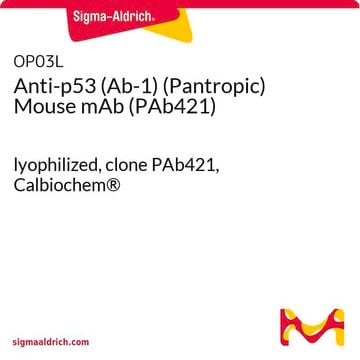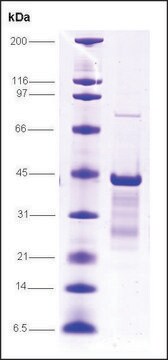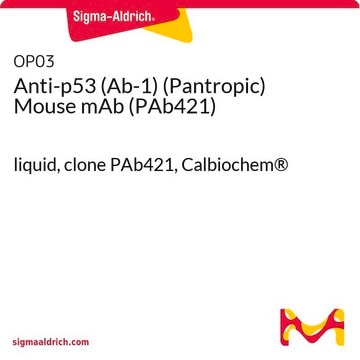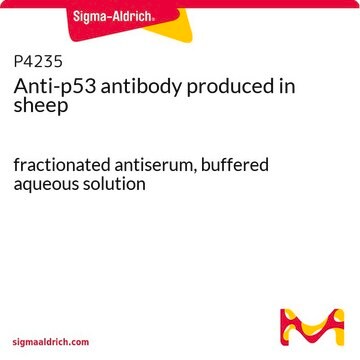推荐产品
生物源
mouse
品質等級
抗體表格
purified immunoglobulin
抗體產品種類
primary antibodies
無性繁殖
PAb421, monoclonal
物種活性
human, mouse
技術
immunohistochemistry: suitable
immunoprecipitation (IP): suitable
western blot: suitable
同型
IgG2aκ
NCBI登錄號
UniProt登錄號
運輸包裝
wet ice
目標翻譯後修改
unmodified
基因資訊
mouse ... Trp53(22059)
一般說明
p53 was discovered in 1979 as a cellular protein associating with the transforming protein of SV40 tumor virus. Since then, many different biochemical functions have been attributed to the 53 kDa phosphoprotein. Experimental evidence has suggested that p53 acts as a negative regulator of cell growth in normal cells). Thus, the inactivation or mutation of p53 may be an essential step in the development of malignancy. Wild-type p53 levels in normal cells and tissues were found to be very low. Mutant p53 polypeptide, however, is often found to be present at high concentrations in mammalian tumors and tumor cell lines. For example, in an immuno-histochemistry study 40% of human breast cancer showed elevated levels of mutant p53 in the cell nucleus. Mutations of the p53 protein have some characteristic features: Most of them are missense point mutations giving rise to an altered protein function. Also, many, but not all, mutant p53 proteins exhibit a common mutant structure, which can be recognized by monoclonal antibodies specific for p53 in the mutant conformation.
特異性
This antibody recognizes amino acids 376-378 of human p53.
免疫原
Epitope: Amino acids 376-378 in human p53
Partially purified mouse p53
應用
Immunoprecipitation Analysis: A representative lot from independent laboratory immunoprecipitated p53 in IP (Lehman, T. A., et al. (1991). Cancer Res. 51(15):4090-4096.; Harlow, E., et al. (1981). J Virol. 39(3):861-869.)
Immunohistochemistry Analysis: A representative lot from an independent laboratory detected p53 in human breast cancer tissue (Davidoff, A. M., et al. (1992). Proc Natl Acad Sci USA. 89(8):3439-3442.).
Immunohistochemistry Analysis: A representative lot from an independent laboratory detected p53 in human breast cancer tissue (Davidoff, A. M., et al. (1992). Proc Natl Acad Sci USA. 89(8):3439-3442.).
Research Category
Epigenetics & Nuclear Function
Epigenetics & Nuclear Function
Research Sub Category
Cell Cycle, DNA Replication & Repair
Cell Cycle, DNA Replication & Repair
Use Anti-p53 Antibody, clone PAb421 (Mouse Monoclonal Antibody) validated in WB, IP, IHC to detect p53 also known as Cellular tumor antigen p53, Tumor suppressor p53.
品質
Evaluated by Western Blot in mouse brain tissue lysate.
Western Blot Analysis: 1 µg/mL of this antibody detected p53 in 10 µg of mouse brain tissue lysate.
Western Blot Analysis: 1 µg/mL of this antibody detected p53 in 10 µg of mouse brain tissue lysate.
標靶描述
~53 kDa observed
外觀
Protein G Purified
Format: Purified
Purified mouse monoclonal IgG2aκ in buffer containing 0.1 M Tris-Glycine (pH 7.4), 150 mM NaCl with 0.05% sodium azide.
儲存和穩定性
Stable for 1 year at 2-8°C from date of receipt.
Note: Variability in freezer temperatures below -20°C may cause glycerol containing solutions to become frozen during storage.
Note: Variability in freezer temperatures below -20°C may cause glycerol containing solutions to become frozen during storage.
分析報告
Control
Mouse brain tissue lysate
Mouse brain tissue lysate
其他說明
Concentration: Please refer to the Certificate of Analysis for the lot-specific concentration.
免責聲明
Unless otherwise stated in our catalog or other company documentation accompanying the product(s), our products are intended for research use only and are not to be used for any other purpose, which includes but is not limited to, unauthorized commercial uses, in vitro diagnostic uses, ex vivo or in vivo therapeutic uses or any type of consumption or application to humans or animals.
Not finding the right product?
Try our 产品选型工具.
儲存類別代碼
12 - Non Combustible Liquids
水污染物質分類(WGK)
WGK 1
閃點(°F)
Not applicable
閃點(°C)
Not applicable
T Okamoto et al.
Oncogene, 19(54), 6194-6202 (2001-02-15)
The Y-box binding protein, YB-1, belongs to a family of multifunctional proteins which regulate gene expression on both transcriptional and translational levels. The tumor suppressor gene p53 displays growth suppressive properties by regulating gene expression through transcriptional regulation. We now
S C Kaul et al.
Neoplasia (New York, N.Y.), 3(2), 110-114 (2001-06-23)
The mouse mot-2 protein was earlier shown to bind to the tumor suppressor protein, p53. The mot-2 binding site of p53 was mapped to C-terminal amino acid residues 312-352, which includes the cytoplasmic sequestration domain. In the present study, we
Rie Takahashi et al.
The Journal of investigative dermatology, 134(3), 791-800 (2013-09-17)
The TP53 gene encodes 12 distinct isoforms, some of which can alter p53 activity in the absence of genomic alteration. Endogenous p53 isoforms have been identified in cancers; however, the function of these isoforms remains unclear. In melanoma, the frequency
Hidetaka Uramoto et al.
The Biochemical journal, 371(Pt 2), 301-310 (2003-01-22)
The CCAAT-binding transcription factor (CTF)/nuclear factor I (NF-I) group of cellular DNA-binding proteins recognizes the sequence GCCAAT and is implicated in eukaryotic transcription, as well as DNA replication. Molecular analysis of human CTF/NF-I cDNA clones revealed multiple mRNA species that
C M Simbulan-Rosenthal et al.
Neoplasia (New York, N.Y.), 3(3), 179-188 (2001-08-09)
The tumor-suppressor p53 undergoes extensive poly(ADP-ribosyl)ation early during apoptosis in human osteosarcoma cells, and degradation of poly(ADP-ribose) (PAR) attached to p53 coincides with poly(ADP-ribose)polymerase-1, (PARP-1) cleavage, and expression of p53 target genes. The mechanism by which poly(ADP-ribosyl)ation may regulate p53
我们的科学家团队拥有各种研究领域经验,包括生命科学、材料科学、化学合成、色谱、分析及许多其他领域.
联系技术服务部门








